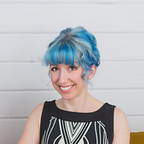How Talking To Your Clients Helps You Beat The Blank Page
Conversations with your ideal readers…
Ever had insomnia? Not just a little trouble sleeping, but the twitchy, panicky, staring into the void teetering-on-the-edge of madness insomnia?
Every now and then, it feels like you’re poised on the knife-edge of sleep — so you grab at it, wildly, desperately, only to feel sleep slip away, leaving you grinding your teeth.
To me, that’s what the Blank Page Of Doom feels like sometimes. When I have the seed of an idea I can’t quite hold onto — or too many ideas, boiling across my brain too swift to catch.
Nothing is solid, and the twitchy frustration sets in. Until eventually I’m throwing magazines at flies and every tiny sound clangs loudly inside my brain.
I learned long ago that there’s no point sitting at my desk and trying to force it. The harder you try to capture an idea, the more slippery it becomes. And that’s a sure sign I haven’t finished thinking yet — or researching.
What most business owners, and many writers, don’t understand is how much thinking is a part of writing a book. You don’t have to be sitting at your desk pounding out words to be writing.
Some of my best writing isn’t writing at all; it’s thinking. (This is why I take a notebook everywhere with me, in case I have a thought worth writing down.)
My goal here is to help you beat the Blank Page Of Doom — and if your problem is capturing that idea or choosing the best idea to write about, but it just won’t seem to come — read on.
The Lost Art Of Listening
Whether you’re writing your book, or a webpage, an article, an email, or a sales letter, start by listening. Listen to the answers they give you to the following questions.
These are the questions I ask my ideal clients and customers when I want to understand exactly how I can help them.
They’re the questions that help me refine my Big Book Ideas, and figure out what problem I’m really solving for people.
When you’ve finished talking — or, rather, listening — you won’t just have a Big Idea for your book, you’ll have a fantastic testimonial for your products and services.
Ask the questions in this order — and let the conversation flow naturally. Don’t skip the last question; it’s where some of the best information will come from.
7 Crucial Questions
- What reason did you have for looking for [your product or service]? What were you struggling with before you found me?
- What was your main concern about working with me [or buying my product]? What worried you the most before you forked over the cash?
- Now you’ve worked with me [or bought my product], how have you found it? What happened?
- What specific feature do you like most about working with me [or my product]? Why?
- What are three other benefits of working with someone like me [or buying a product like this]? What did they do for you?
- Would you recommend me to anyone else? Why?
- Is there anything else you’d like to add?
Then, I’d add one more question:
Would you be interested in a book that would help you understand and solve your biggest challenge?
These questions tell your customer’s — your ideal reader’s — story. They start at the beginning, the problem you’re solving, and take them right to the end: the place where your customers and clients want to be.
They enable you to pull out all the details, including information you will never have thought of.
You’ll discover benefits you never even knew existed about your business.
And your ideal clients will tell you exactly what they find most valuable about you and your business. They’ll show you what their biggest struggle is, and how you helped them fix it.
That’s your Big Book Idea.
That’s what you can start writing about.
Each person you speak to will have a different story to tell, but there’ll be common threads running through their tales. The big problem you’re solving will almost certainly be the same for each person — and the nuances in their journeys will give you plenty of fodder for your book.
The common thread is your Big Book Idea.
Tease it out and write it down.
Then use it to create your outline.
Talk, Then Write
Listen to your ideal clients. Talk to your best, most profitable customers. Take them for lunch, and let them talk. Set up a video call. Record the conversation if you can — or make as many notes as possible.
Listen to the language they use, look at their facial expressions, note down their emotions. Where do they get animated, and where do they fall silent?
This is how I start writing all my books — my own and those of my ghostwriting clients. Without knowing my ideal reader inside-out, how can I possibly expect to write a book they want to read?
Without knowing your ideal reader inside-out, you’ll struggle too.
So seek them out and listen to them — and beat the Blank Page Of Doom.
Want more articles about beating writer’s block? Try these:
